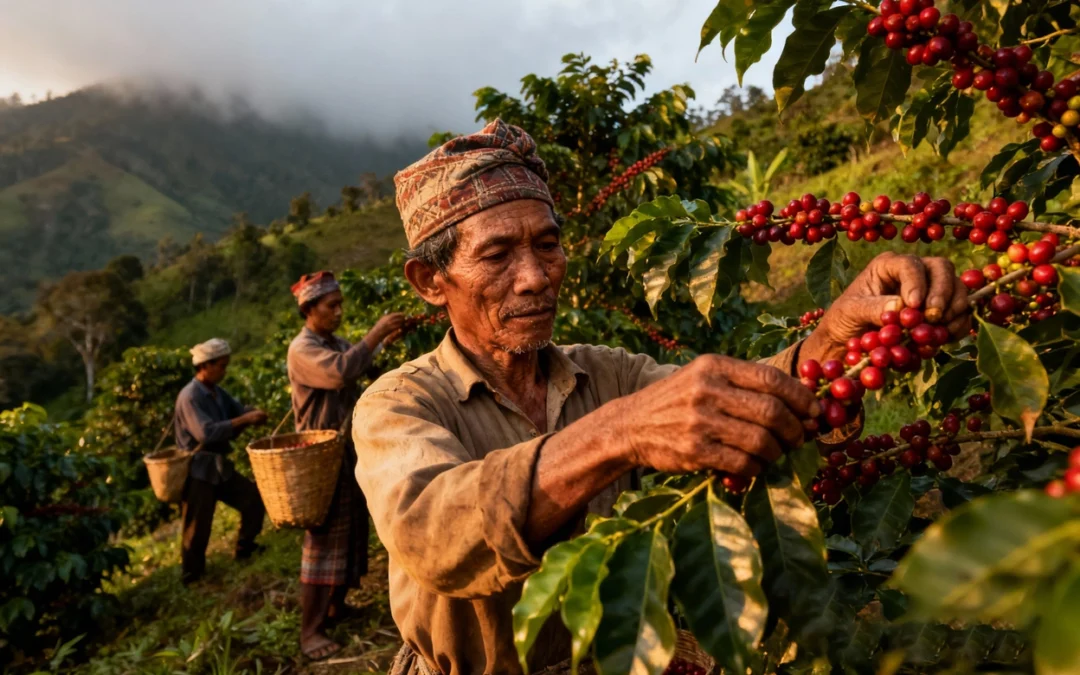How coffee farmers in Indonesia are navigating production challenges, climate change, specialty markets, and the global coffee value chain
Coffee Farmers Indonesia and the Journey Ahead
Coffee farmers Indonesia have long operated on the front lines of one of the world’s most beloved beverages. In this article, we explore who they are, how they farm, what challenges they face—from climate and market to value chain—and where new opportunities lie for these producers.
The Scale and Profile of Coffee Farming in Indonesia
Coffee farmers Indonesia operate within a large and diverse coffee sector. Indonesia is the world’s fourth-largest producer, yielding roughly 660,000 metric tons of coffee annually.
According to World Coffee Research, over 80% of the nation’s coffee-growing area is managed by smallholder farmers. Most cultivate robusta, which thrives at lower altitudes and represents around 80% of national output, while arabica—grown in higher-altitude regions such as Sumatra, Java, and Sulawesi—commands higher prices in specialty markets.
Geographically, coffee cultivation spans about 1.3 million hectares across islands like Sumatra, Java, Sulawesi, and Papua. (Jurnal UMSU) This diversity means coffee farmers Indonesia are not a single group but a network of families, cooperatives, and estates—each facing unique conditions, from soil to access to markets.
Understanding this structure is essential because when we talk about coffee farmers Indonesia, we refer to a vast and complex ecosystem that fuels one of the most important agricultural exports in the country.
Farming Practices and Production – What Coffee Farmers Indonesia Actually Do
Farming practices among coffee farmers Indonesia depend heavily on location, altitude, and coffee variety. A hallmark of Indonesian production is the giling basah or wet-hulling process, unique to regions like Sumatra and Sulawesi. (Wikipedia – Giling Basah) This technique gives Indonesian arabica its distinctive heavy body and earthy flavour profile.
Smallholders typically manage less than one hectare per farm, relying heavily on manual labor for harvesting and processing. Yields remain below the global average because many trees are old or of outdated varieties. (World Coffee Research)
After harvest, cherries are pulped, fermented, hulled, and dried—often without advanced infrastructure. Sucafina reports that inconsistent drying conditions and limited access to modern post-harvest facilities often lower quality and price potential.
To combat this, initiatives across the archipelago promote better agronomic practices, access to training, and cooperative organization. These steps help coffee farmers Indonesia improve yields, ensure consistent quality, and secure fairer market prices.
Key Challenges Facing Coffee Farmers Indonesia
Despite Indonesia’s global ranking, coffee farmers Indonesia face deep structural issues.
According to Medium’s analysis of the industry, many smallholders receive less than $0.50 for every cup sold internationally.
The major hurdles include:
- Market Inequality: Limited access to direct buyers and reliance on intermediaries reduces income.
- Climate and Environmental Stress: The Stockholm Environment Institute highlights rising temperatures, shifting rainfall, and pest outbreaks threatening yields.
- Ageing Trees and Low Productivity: Around 70% of Indonesia’s coffee trees require renovation or replanting. (World Coffee Research)
- Infrastructure and Financing Gaps: Rural roads, processing facilities, and access to credit remain weak.
- Traceability and Quality Pressures: Global buyers increasingly demand traceable, certified, and sustainable beans—a challenge for small farmers. (Specialty Coffee Association of Indonesia)
These interconnected problems mean coffee farmers Indonesia are caught between production constraints, climate risks, and market pressures. But as we’ll see next, new opportunities are emerging that could redefine their future.
Emerging Opportunities for Coffee Farmers Indonesia
The future holds promise for coffee farmers Indonesia, especially through specialty coffee, sustainability, and direct-trade models.
World Coffee Research notes that Indonesian arabica—particularly from Gayo, Java, and Toraja—has exceptional flavour diversity, which is highly valued in specialty markets. The Specialty Coffee Association of Indonesia trains thousands of smallholders on quality standards, cupping, and certification to help access those markets.
Climate-smart practices, promoted by organizations like the Stockholm Environment Institute, are another vital opportunity. These involve shade-growing, intercropping, water conservation, and disease monitoring to enhance resilience and qualify for sustainability premiums.
Value-chain integration and direct trade also enable cooperatives to keep a larger share of profits. Protected geographic indications such as “Gayo Coffee” or “Java Arabica” boost traceability and add market value.
With global demand rising for origin-specific, ethical, and sustainable coffee, coffee farmers Indonesia stand well-positioned to benefit—if they can align production and marketing with these emerging trends.
What Needs to Happen Next for Coffee Farmers Indonesia
To turn potential into prosperity, coordinated action is crucial.
At the Farmer Level
Replanting old trees, improving agronomic methods, adopting high-yield varieties, and mastering post-harvest processing will directly improve both quality and income.
At the Cooperative Level
Local groups and associations such as the Specialty Coffee Association of Indonesia should continue providing training, financing assistance, and shared processing facilities.
At the Policy Level
Government investment in infrastructure, extension services, and climate programs—like the field schools highlighted by SEI—is essential to ensure resilience and modernization.
At the Market Level
Global buyers and roasters must create transparent supply chains, reward quality with fair premiums, and foster long-term relationships with cooperatives.
If these levels align, coffee farmers Indonesia can transition from commodity sellers to empowered entrepreneurs, ensuring that Indonesia’s coffee legacy continues to thrive for decades.
In conclusion, Coffee farmers Indonesia face a challenging yet promising path. Despite low margins, climate pressures, and infrastructure gaps, new opportunities in specialty coffee, sustainable farming, and traceable trade are reshaping their prospects. By supporting these farmers through fair markets, training, and sustainable policies, we invest in communities—and ensure every cup of Indonesian coffee tells a story of resilience and renewal.

